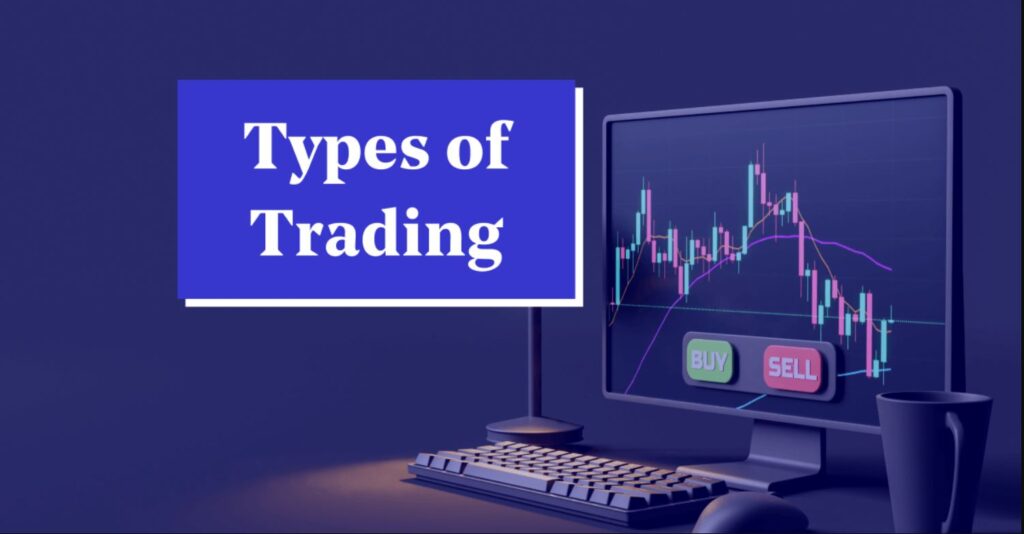In essence, trading is the transfer of goods and services between two entities. The entities here are traders and investors who are trading stocks in various companies. The stock market is the venue for stock trading. Due to online trading and investing, stock markets have become accessible to a larger section of people.
Hey newbies, today in this blog we will be discussing about the basics, yet essential, of Stock Market Trading and its types.

Understanding the fundamentals and Definition
What is Trading?
Buying and selling financial assets in markets to turn a profit is referred to as trading. It entails analyzing market trends and seeing openings to join the market to generate a profit.
A Glance over Stock Market Trading
Stock market investors typically select a trading strategy from a variety of options depending on their desired duration of investment stay, their financial objective, and their attitude toward stock trading. In general, there are two main types of trading: long-term and short-term.
However, there are two types of trading when you separate them according to investing strategies: technical trading and fundamental trading. Additionally, there is intraday trading, swing trading, and positional trading when we group the different types of trading according to the time frame. Because these various trading methods have certain features in common, they tend to overlap.
For instance, technical trading is similar to intraday trading, and fundamental trading has a resemblance to positional trading.
Types of Trading in the Stock Market

1. Intraday Trading
Day trading is another name for intraday trading. Trading during the same day i.e. an investor buys and sells stocks on the same day, is referred to as intraday trading. It simply means that if an investor purchases a set of shares on a given day, they have to sell those shares before the market closes for the day. This form of trading lets the investors make use of margins, where they avail credit from a broker.
Note: Single Day in stock market term means, 9.15 am to 3.30 pm on a weekday.
Proficiency in market affairs, a deep comprehension of market volatility, and an acute awareness of when stock prices are rising and falling are necessary for day trading. Hence, it is primarily carried out by experienced traders or investors.
2. Scalping
It is also known as micro-trading. Within intraday trading, there are two subsets: scalping and day trading. Recurring small profits, typically between a dozen and a hundred in a single market day, are the goal of scalping.
But not every deal results in profit, and occasionally a trader’s total losses could outweigh their gains. In contrast to day trading, the holding period of securities in this scenario is shorter—people retain equities for a maximum of a few minutes.
This feature allows for the frequency of transactions. Like day trading, scalping necessitates market knowledge, skill, awareness of market movements, and quick transactions.
Track the latest trends of GIFT Nifty Chart here!
3. Delivery Trading
One of the safest methods of making stock market investments is through delivery trading, which is a type of long-term investment. In the stock market, this type of trading is the most common. Delivery trading is done by the investor to hold onto their purchased stocks for a longer amount of time.
Delivery trading, in contrast to intraday trading, prohibits the use of margins and requires that the investor have the necessary funds in hand. The investor is required to pay the whole amount for all transactions in this sort of trading. Delivery trading only requires the delivery of stocks to the appropriate demat account; and does not impose any time constraints on stock trading.

Delivery trading offers investors the chance to get significant dividends, voting rights, and other benefits from the company they have invested in. Under this kind of trade, there is never a case of short selling. Delivery trading undoubtedly generates significant gains for the investor, since the company’s growth is reflected in the dividends paid to the investor over time.
Since there are no margins permitted in delivery trading, the investor needs to make the entire payment. Due to limited access to capital, this could result in the loss of investment prospects.
4. Swing Trading
The purpose of this type of stock market trading is to profit from short-term patterns and trends in stocks. The goal of swing trading is to make money on stocks, one to seven days after purchase, ideally. Technical analysis is used by traders to assess the patterns of movement in the equities they are tracking to effectively execute their investing goals.
Swing trading is primarily distinguished from other forms of trading by its time frame. A trader who engages in swing trading will only hold the stocks for a few weeks at most.
5. Momentum Trading
In momentum trading, a trader takes advantage of a stock’s momentum, which is a significant move in the stock’s value, either up or down. A trader looks for stocks that are breaking out or are about to break out in an attempt to profit from this momentum.
When there is an upward trend, the trader sells the stocks they are holding, resulting in returns that are larger than average. When a stock price is declining, the trader buys a large number of the stock to sell when it rises.
6. Position Trading
A “buy and hold” approach is the foundation of positional trading. It demands that traders retain their stocks for a lengthy time. Day traders want to react to even the smallest changes in the stock market, while position traders only make money when they hold onto their positions until there is a noticeable price increase.
In addition to providing substantial returns, this type of trading does not necessitate constant observation of one’s trading profile and market circumstances.

However because positional trading entails long-term ownership of the company’s stocks, it necessitates extensive research and analysis before stock purchases.
7. Options Trading
Without really owning the stock, you can speculate on future price movements of stocks through options trading. If you think the stock price will climb, you can purchase “call” options; if you think it will decrease, you can purchase “put” options
Every option has a strike price and an expiration date. The option might be beneficial if the stock advances in the way you predicted. Although options provide leverage, there is a chance you could lose your initial investment. They offer flexibility beyond typical stock trading and are useful tools for speculating and hedging.
Final Verdict
In a nutshell, Online trading has had a revolutionary effect, changing the financial landscape. The accessibility, cost efficiency, real-time information, and global reach of Stock Market have empowered individual investors like never before. It’s made things like buying stocks or other financial things way easier for regular folks. Now, we can trade whenever, get real-time info, and even use smart computer programs to help. But, like with anything important, it’s got good parts and some risks. So, as we keep exploring this online trading world, it’s smart to learn more, be careful, and make decisions that make sense for us.
Also Read: Stock Scam Spotlights
FAQs
Trade can be defined as the buying and selling of goods, services, and more.
Buying and selling shares of a specific company is known as stock market trading. Owning a certain stock or share in a firm corresponds to having a portion of the company in the form of ownership.
Online trading is a famous method of transacting financial products online when an online user places a buying order for stock online.